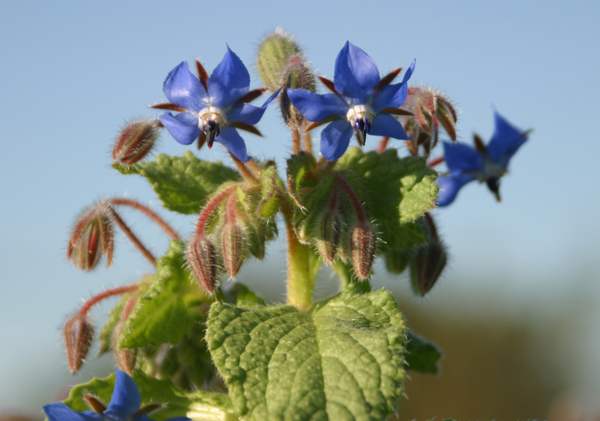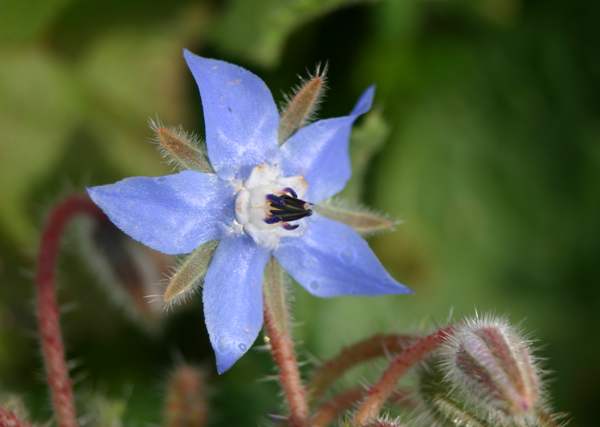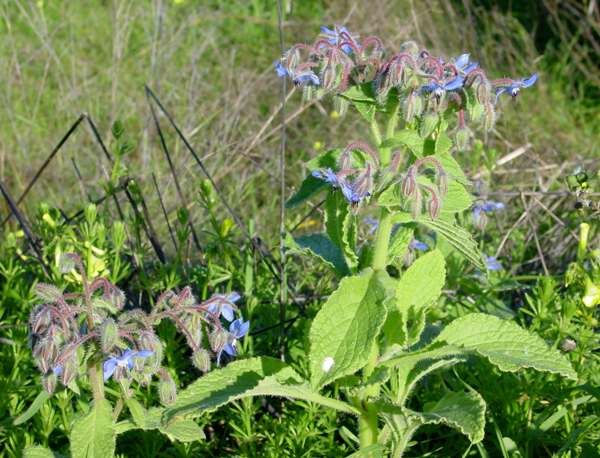Trees Birds Mammals Fish Amphibians Reptiles
Wild Algarve
Bookshop
Borago officinalis - Borage
Phylum: Magnoliophyta - Class: Equisetopsida - Order: insertae sedis - Family: Boraginaceae

Why such a lovely wildflower should hang its head in shame is a mystery, but the pendent flowers of Borage are best viewed from a lying-down position.
Description
Up to 60cm tall, this bristly branching annual herb has pointed oval leaves with toothed wavy margins. The bright blue flowers of Borage, each with five pointed recurved petals and an extended column of purple-black-tipped anthers, range from 2 to 12.5m across and grow in loose clusters (cymes).

Distribution
This gorgeous plant, which is established on a few roadsides and in waste ground in southern Britain, is cultivated as a culinary herb in summertime. Borage is common throughout the Mediterranean region of southern Europe, including the Algarve in Portugal where, as well as reproducing from seed annually, it is also capable of over-wintering.

Habitat
Borago officinalis is a wildflower of fallow cultivated land, disturbed roadsides and waste ground. It thrives in sunny locations and copes surprisingly well during dry periods.
Blooming Times
Borage blooms from March to June within its native Mediterranean range but throughout the summer months in Britain and Ireland.
Uses
Not surprisingly, Borage has been grown mainly as an ornamental plant, although its leaves are used to flavour drinks - notably Pimms. These days the plant is also grown in cultivation for its oil-rich seeds.
Etymology
The origin of the ancient genus name Borago seems to be lost in the mists of time, but the specific epithet officinalis indicates that this plant was considered to have medicinal properties.
Similar Species
Borage is one of many members of this family to occur widely throughout the Mediterranean region. Another common species with even deeper blue flowers is Anchusa azurea (Large Blue Alkanet).
The Borage plants shown on this page were photographed in southern Portugal during early March.
Sue Parker's latest ebook is a revised and enlarged second edition of the acclaimed Wildflowers in the Algarve - an introductory guide. Full details here...
Buy it for just £3.95 on Amazon...
Sue Parker's 5-star acclaimed field guide to the Wild Orchids of the Algarve is now available as an ebook. Full details here...
Buy it for just £5.95 on Amazon...
Please Help Us: If you have found this information interesting and useful, please consider helping to keep First Nature online by making a small donation towards the web hosting and internet costs.
Any donations over and above the essential running costs will help support the conservation work of Plantlife, the Rivers Trust and charitable botanic gardens - as do author royalties and publisher proceeds from books by Pat and Sue.